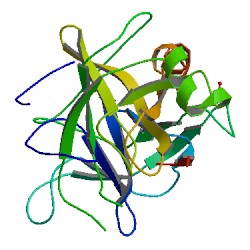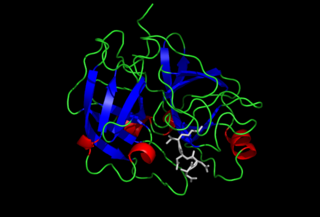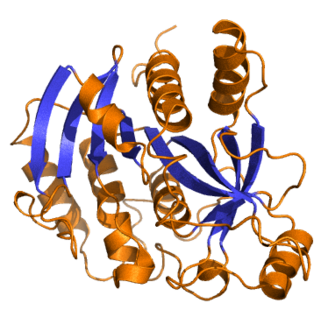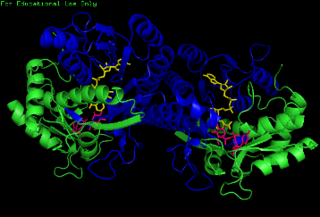Related Research Articles

Chymotrypsin (EC 3.4.21.1, chymotrypsins A and B, alpha-chymar ophth, avazyme, chymar, chymotest, enzeon, quimar, quimotrase, alpha-chymar, alpha-chymotrypsin A, alpha-chymotrypsin) is a digestive enzyme component of pancreatic juice acting in the duodenum, where it performs proteolysis, the breakdown of proteins and polypeptides. Chymotrypsin preferentially cleaves peptide amide bonds where the side chain of the amino acid N-terminal to the scissile amide bond (the P1 position) is a large hydrophobic amino acid (tyrosine, tryptophan, and phenylalanine). These amino acids contain an aromatic ring in their side chain that fits into a hydrophobic pocket (the S1 position) of the enzyme. It is activated in the presence of trypsin. The hydrophobic and shape complementarity between the peptide substrate P1 side chain and the enzyme S1 binding cavity accounts for the substrate specificity of this enzyme. Chymotrypsin also hydrolyzes other amide bonds in peptides at slower rates, particularly those containing leucine at the P1 position.

A protease is an enzyme that catalyzes proteolysis, breaking down proteins into smaller polypeptides or single amino acids, and spurring the formation of new protein products. They do this by cleaving the peptide bonds within proteins by hydrolysis, a reaction where water breaks bonds. Proteases are involved in many biological functions, including digestion of ingested proteins, protein catabolism, and cell signaling.

The cantaloupe, rockmelon, sweet melon, or spanspek are a type of fruit. They are classified as a melon that is a variety of the muskmelon species from the family Cucurbitaceae.

A melon is any of various plants of the family Cucurbitaceae with sweet, edible, and fleshy fruit. The word "melon" can refer to either the plant or specifically to the fruit. Botanically, a melon is a kind of berry, specifically a "pepo". The word melon derives from Latin melopepo, which is the latinization of the Greek μηλοπέπων (mēlopepōn), meaning "melon", itself a compound of μῆλον (mēlon), "apple", treefruit " and πέπων (pepōn), amongst others "a kind of gourd or melon". Many different cultivars have been produced, particularly of cantaloupes.

Cucumis is a genus of twining, tendril-bearing plants in the family Cucurbitaceae which includes the cucumber, muskmelons, the horned melon, and the West Indian gherkin.

Enteropeptidase is an enzyme produced by cells of the duodenum and is involved in digestion in humans and other animals. Enteropeptidase converts trypsinogen into its active form trypsin, resulting in the subsequent activation of pancreatic digestive enzymes. Absence of enteropeptidase results in intestinal digestion impairment.

A catalytic triad is a set of three coordinated amino acids that can be found in the active site of some enzymes. Catalytic triads are most commonly found in hydrolase and transferase enzymes. An acid-base-nucleophile triad is a common motif for generating a nucleophilic residue for covalent catalysis. The residues form a charge-relay network to polarise and activate the nucleophile, which attacks the substrate, forming a covalent intermediate which is then hydrolysed to release the product and regenerate free enzyme. The nucleophile is most commonly a serine or cysteine amino acid, but occasionally threonine or even selenocysteine. The 3D structure of the enzyme brings together the triad residues in a precise orientation, even though they may be far apart in the sequence.

Purine nucleoside phosphorylase, PNP, PNPase or inosine phosphorylase is an enzyme that in humans is encoded by the NP gene. It catalyzes the chemical reaction
Aspergillopepsin I is an enzyme. This enzyme catalyses the following chemical reaction

Thermolysin is a thermostable neutral metalloproteinase enzyme produced by the Gram-positive bacteria Bacillus thermoproteolyticus. It requires one zinc ion for enzyme activity and four calcium ions for structural stability. Thermolysin specifically catalyzes the hydrolysis of peptide bonds containing hydrophobic amino acids. However thermolysin is also widely used for peptide bond formation through the reverse reaction of hydrolysis. Thermolysin is the most stable member of a family of metalloproteinases produced by various Bacillus species. These enzymes are also termed 'neutral' proteinases or thermolysin -like proteinases (TLPs).

TEV protease is a highly sequence-specific cysteine protease from Tobacco Etch Virus (TEV). It is a member of the PA clan of chymotrypsin-like proteases. Due to its high sequence specificity, TEV protease is frequently used for the controlled cleavage of fusion proteins in vitro and in vivo.
Fruit bromelain is an enzyme. This enzyme catalyses the following chemical reaction

Caspase-6 is an enzyme that in humans is encoded by the CASP6 gene. CASP6 orthologs have been identified in numerous mammals for which complete genome data are available. Unique orthologs are also present in birds, lizards, lissamphibians, and teleosts. Caspase-6 has known functions in apoptosis, early immune response and neurodegeneration in Huntington's and Alzheimer's disease.

Calpain-2 catalytic subunit is a protein that in humans is encoded by the CAPN2 gene.

The enzyme UDP-glucose 4-epimerase, also known as UDP-galactose 4-epimerase or GALE, is a homodimeric epimerase found in bacterial, fungal, plant, and mammalian cells. This enzyme performs the final step in the Leloir pathway of galactose metabolism, catalyzing the reversible conversion of UDP-galactose to UDP-glucose. GALE tightly binds nicotinamide adenine dinucleotide (NAD+), a co-factor required for catalytic activity.

Calpain-1 catalytic subunit(CANP 1) is a protein that in humans is encoded by the CAPN1 gene.

Dipeptidyl-peptidase 3 is an enzyme that in humans is encoded by the DPP3 gene.

An Oligopeptidase is an enzyme that cleaves peptides but not proteins. This property is due to its structure: the active site of this enzyme is located at the end of a narrow cavity which can only be reached by peptides.
Oryzin is an enzyme. This enzyme catalyses the following chemical reaction
Rhizopuspepsin is an enzyme. This enzyme catalyses the following chemical reaction
References
- ↑ Greenberg DM, Winnick T (1940). "Plant proteases. I. Activation-inhibition reactions". J. Biol. Chem. 135: 761–773.
- ↑ Jaffé WG (1943). "Hurain, a new plant protease from Hura crepitans". J. Biol. Chem. 149: 1–7.
- ↑ Jaffé WG (1943). "A new vegetable proteolytic enzyme of the papain class". Rev. Brasil Biol. 3: 149–157.
- ↑ Kaneda M, Tominaga N (December 1975). "Isolation and characterization of a proteinase from the sarcocarp of melon fruit". Journal of Biochemistry. 78 (6): 1287–96. PMID 5423.
- ↑ Kaneda M, Ohmine H, Yonezawa H, Tominaga N (March 1984). "Amino acid sequence around the reactive serine of cucumisin from melon fruit". Journal of Biochemistry. 95 (3): 825–9. PMID 6427203.
- ↑ Lynn KR, Clevette-Radford NA (1985). "Two proteases from the latex of Elaeophorbia drupifera". Phytochemistry. 24: 2843–2845. doi:10.1016/0031-9422(85)80011-x.
- ↑ Kaneda N, Minematsu Y, Powers JC, Tominaga N (1986). "Specificity of cucumisin in hydrolysis of peptide thiobenzyl esters". Agric. Biol. Chem. 50: 1075–1076. doi: 10.1271/bbb1961.50.1075 .
- ↑ Sankian M, Talebi F, Moghadam M, Vahedi F, Jabbari Azad F, Varasteh A (2011). "Molecular Cloning and Expression of Cucumisin (Cuc m 1), a Subtilisin-like Protease of Cucumis melo in Escherichia coli". Allergology International. 60 (1): 61–67. doi: 10.2332/allergolint.10-OA-0195 .